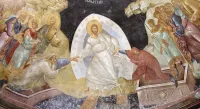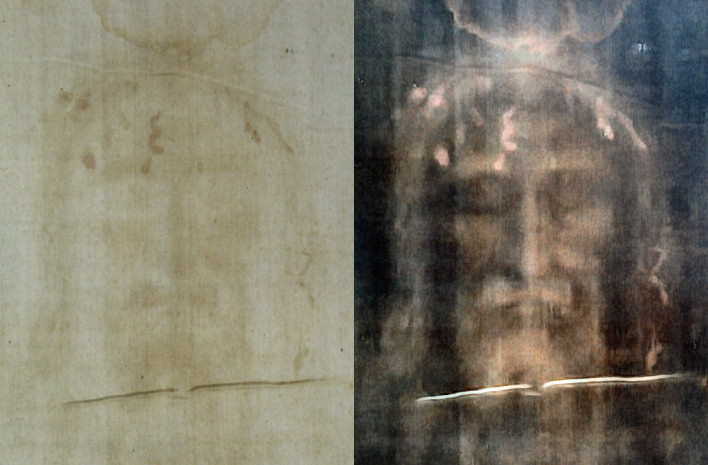The Shroud of Turin is a linen cloth bearing an image believed by some to be that of Jesus of Nazareth after his crucifixion. Revered for centuries, especially within the Catholic Church, it's considered by some to be Jesus' burial shroud, miraculously imprinted with his image. The image is clearer in negative, a discovery made in 1898 by Secondo Pia, which led to the popular Catholic devotion to the Holy Face of Jesus. The shroud's authenticity remains a subject of debate, with various scientific studies and interpretations contributing to the ongoing discussion.
1902: Initial study by Yves Delage
In 1902, Yves Delage conducted an initial study on the anatomical consistency of the image on the shroud, declaring the image anatomically flawless.
1931: Giuseppe Enrie's photograph of the shroud
In 1931, Giuseppe Enrie photographed the Shroud of Turin and obtained results similar to Secondo Pia's.
1931: Giuseppe Enrie's photograph
In 1931, Giuseppe Enrie took a photographic negative of the Shroud. A reproduction of this negative was later used in a 2011 study by Salvatore Lorusso and others, where detailed modern digital image processing found no images of flowers, coins, or anything else on either image.
1936: Maria Pierina De Micheli's visions
In 1936, Maria Pierina De Micheli reported having visions of Jesus, initiating the modern devotion to the Holy Face centered on the negative photographic image from the Shroud of Turin.
1936: Pius XII references the Shroud
In 1936, Pius XII referred to the Shroud as a "holy thing perhaps like nothing else".
1940: Approval for Holy Face Medal requested
In 1940, Sister Maria Pierina De Micheli requested authorization from the curia of Milan to produce a devotional medal based on the image of Jesus's face from the Shroud of Turin.
1950: Usage of 'sindonological'
The usage of 'sindonological' was identified in 1950, regarding study of the Shroud of Turin.
1953: Usage of 'sindonologist'
The usage of 'sindonologist' was identified in 1953, regarding study of the Shroud of Turin.
1964: First use of the word 'sindonology'
In 1964, the Oxford English Dictionary cited the first use of the word 'sindonology' to describe the formal study of the Shroud of Turin.
1969: First direct examination by scientific team
The first direct examination of the Shroud of Turin by a scientific team was undertaken in 1969 to advise on preservation and determine specific testing methods.
1973: Preliminary studies of fabric samples
In 1973, preliminary studies of samples of the fabric of the Shroud of Turin were conducted after the appointment of an 11-member Turin Commission.
1976: Image Analysis Technologies Used
In 1976, physicist John P. Jackson, thermodynamicist Eric Jumper and photographer William Mottern used image analysis technologies developed in aerospace science for analyzing the images of the Shroud of Turin.
1976: NASA imaging equipment analysis
In 1976, scientists used NASA imaging equipment to analyze a photograph of the shroud image and decoded it into a three-dimensional image.
1977: Formation of the Shroud of Turin Research Project
In 1977, the Shroud of Turin Research Project was formed by John P. Jackson, Eric Jumper, William Mottern, and over thirty other experts in various fields.
1977: Vacuuming of the shroud
In 1977, the shroud and its backing cloth were vacuumed, and the collected material was later analyzed in a 2015 study by Barcaccia et al., which examined the human and non-human DNA found in the vacuumed material.
October 1978: STURP took 32 samples from the surface of the Shroud
In October 1978, a team of scientists affiliated with STURP took 32 samples from the surface of the Shroud, using adhesive tape.
1978: 3D-elaboration and electronic removal of blood
In 1978, Giovanni Tamburelli obtained a 3D-elaboration from the Shroud with higher resolution and electronically removed the blood from the image.
1978: Joe Nickell's hypothesis on the shroud creation
In 1978, Joe Nickell hypothesized that a medieval rubbing technique, involving a bas-relief sculpture, was used to create the Shroud image and demonstrated this technique.
1978: Microscopic examination of shroud samples
In 1978, Walter McCrone examined samples taken from the surface of the Shroud of Turin and determined that the image had been painted with red ochre pigment in a gelatin medium. He also concluded that the apparent bloodstains were painted with vermilion pigment, also in a gelatin medium.
1978: Direct access to the Shroud granted to STURP
In 1978, direct access to the Shroud of Turin was granted to the Shroud of Turin Research Project (STURP).
1978: Ultraviolet photographs of the shroud
In 1978, ultraviolet photographs were taken of the Shroud of Turin.
1978: Debate about the Pray Codex
Since 1978, an image in the medieval manuscript of the Pray Codex (c. 1192–1195) has generated a debate among some believers, with some suggesting that features of the drawing point towards a possible attempted representation of the linen cloth.
June 1980: McCrone resigned from STURP
In June 1980, Walter McCrone resigned from the Shroud of Turin Research Project (STURP).
1980: McCrone published his analysis of the Shroud
After his analysis of the Shroud was first published in 1980, McCrone continued to argue in journal articles, public lectures, that the Shroud of Turin had been painted in the 14th century and that it showed no traces of actual blood.
1983: Joe Nickell's statement on the image proportions
In 1983, Joe Nickell stated that the proportions of the image on the shroud are not realistic.
1983: Ownership passed to Catholic Church
In 1983, ownership of the Shroud of Turin passed from the House of Savoy to the Catholic Church, following the death of former King Umberto II.
1983: Shroud Bequeathed to Holy See
In 1983, the Shroud of Turin remained the property of the House of Savoy until it was bequeathed to the Holy See according to the terms of the will of former King Umberto II of Italy.
1988: Radiocarbon dating tests carried out
In 1988, independent radiocarbon dating tests were carried out at the University of Oxford, the University of Arizona, and the Swiss Federal Institute of Technology, which concluded with 95% confidence that the material dated to 1260–1390 AD.
1988: Radiocarbon dating of the shroud
In 1988, radiocarbon dating by three independent laboratories established that the Shroud of Turin dates back to the Middle Ages, between the years 1260 and 1390.
1988: Vacuuming of the shroud backing cloth
In 1988, the shroud's backing cloth was vacuumed, and the collected material was later analyzed in a 2015 study by Barcaccia et al., which examined the human and non-human DNA found in the vacuumed material.
1996: Publication of 'Judgment Day for the Shroud of Turin'
In 1996, McCrone's book 'Judgment Day for the Shroud of Turin' appeared, arguing that the Shroud had been painted in the 14th century and that it showed no traces of actual blood.
April 1997: Fire Threatens the Shroud
On April 11, 1997, a fire, possibly caused by arson, threatened the Shroud of Turin.
May 1998: Pope John Paul II's address at Turin Cathedral
On Sunday May 24, 1998, Pope John Paul II gave an address at the Turin Cathedral for the occasion of the 100th year of Secondo Pia's photograph, stating that the Shroud is an image of God's love as well as of human sin.
1998: Pope John Paul II calls Shroud a relic
In 1998, Pope John Paul II called the Shroud of Turin a "distinguished relic" and "a mirror of the Gospel".
1998: Joe Nickell on herringbone weave
In 1998, shroud researcher Joe Nickell noted that no examples of herringbone weave are known from the time of Jesus, while burial cloths from that era are made using plain weave.
2000: McCrone receives ACS National Award
In 2000, McCrone was awarded the American Chemical Society's National Award in Analytical Chemistry for his work on the Shroud of Turin.
2000: Public showing arranged by Pope John Paul II
In 2000, Pope John Paul II arranged for a public showing of the Shroud of Turin.
2000: Discovery of a 1st-century burial shroud
In 2000, fragments of a burial shroud from the 1st century were discovered in a tomb near Jerusalem, believed to have belonged to a Jewish high priest or member of the aristocracy. Researchers concluded that the Turin Shroud did not originate from Jesus-era Jerusalem based on this discovery.
2002: Restoration of the Shroud
In 2002, the Holy See had the Shroud of Turin restored. The cloth backing and thirty patches were removed, making it possible to photograph and scan the reverse side of the cloth.
2004: Discovery of a faint part-image
In 2004, a faint part-image of the body was found on the back of the Shroud of Turin, after the cloth backing was removed.
2005: Jacques di Costanzo's bas-relief construction
In 2005, researcher Jacques di Costanzo constructed a bas-relief of a Jesus-like face and draped wet linen over it, creating an image similar to that of the face on the Shroud.
2007: Analysis of a crucified Roman
In 2007, the analysis of a crucified Roman discovered near Venice showed heel wounds that are consistent with those found on Jehohanan but not consistent with wounds depicted on the shroud.
2009: Luigi Garlaschelli's reproduction
In 2009, Luigi Garlaschelli, professor of organic chemistry at the University of Pavia, stated that he had made a full-size reproduction of the Shroud of Turin using only medieval technologies.
May 2010: Public Display in Turin
From April 10 to May 23, 2010, the Shroud of Turin was placed back on public display in Turin for the 18th time in its history; more than 2 million visitors came to see it.
2010: National Geographic documentary
In 2010, Garlaschelli's reproduction of the Shroud of Turin was shown in a National Geographic documentary.
2010: Gregory S. Paul's statement on image proportions
In 2010, Gregory S. Paul stated that the proportions of the image are not realistic. Paul argued that the face and proportions of the shroud image are impossible, that the figure cannot represent that of an actual person and that the posture was inconsistent.
2011: Lorusso's study on images of flowers and coins
In 2011, Lorusso and others subjected two photographs of the shroud to detailed modern digital image processing and found no images of flowers or coins or writing or any other additional objects on the shroud in either photograph.
2011: Digital image processing of shroud photographs
In 2011, Salvatore Lorusso and others at the University of Bologna subjected two photographs of the shroud to detailed modern digital image processing and found no images of flowers, coins, or anything else on either image.
March 2013: Exposition of the shroud in Turin Cathedral
On March 30, 2013, as part of the Easter celebrations, there was an exposition of the Shroud of Turin in the Cathedral of Turin.
2013: Pope Francis's reference to the Shroud
In 2013, Pope Francis referred to the Shroud of Turin as an "icon of a man scourged and crucified".
2013: High-definition images streamed
On Holy Saturday, March 30, 2013, images of the Shroud of Turin were streamed on various websites and on television for the first time in 40 years.
April 2015: Shroud Displayed in Turin
From April 19, 2015, the Shroud of Turin was again placed on display in the cathedral in Turin.
June 2015: End of Shroud Display
June 24, 2015, marked the end of the display of the Shroud of Turin in the cathedral in Turin.
June 2015: Pope Francis's pilgrimage to Turin
On June 21, 2015, Pope Francis went on a pilgrimage to Turin to pray before and venerate the Holy Shroud and honor St. John Bosco on the bicentenary of his birth.
2015: DNA study published in Scientific Reports
In 2015, Barcaccia et al. published a study in Scientific Reports examining human and non-human DNA from the shroud. They found traces of 19 plant taxa from various regions and human mtDNA sequences typical of diverse ethnicities. The scientists confirmed that many people from many different places came in contact with the shroud.
2018: Experimental Bloodstain Pattern Analysis (BPA)
In 2018, an experimental Bloodstain Pattern Analysis (BPA) was performed, comparing blood flow patterns from wounds of a crucified person to the evidence on the Turin Shroud, revealing inconsistencies that suggest the shroud may be an artistic representation.
2020: Radiocarbon dating analysis
In 2020, the most recent statistical analysis of radiocarbon dating data suggests that if the Zurich and Tucson data were displaced upward by 88 RCY, all the results would agree within the observed uncertainty, indicating a potential need for adjustment in the data.
Mentioned in this timeline

Pope Francis is the current head of the Catholic Church...

The Catholic Church the largest Christian church globally with over...

A dictionary is a reference work containing lexemes from one...
Italy officially the Italian Republic is a nation in Southern...
NASA established in is the US federal agency responsible for...

Easter is a Christian holiday celebrating the resurrection of Jesus...
Trending

27 minutes ago Josh Giddey cleared for Bulls play-in game; Pressure to perform in postseason.

27 minutes ago Governor Moore Faces Pressure on Child Victims Act Amendment, Veto Urged

28 minutes ago Twins Acquire Jonah Bride from Marlins to strengthen their Roster depth.

28 minutes ago Government Cheese: Surreal Comedy in San Fernando Valley Reviewed on Apple TV+

28 minutes ago Fyre Festival 2 Postponed Indefinitely; Fate Uncertain After Resort Relocation Issues

Shawn Levy is a Canadian filmmaker actor and founder of Laps Entertainment Known for directing films across various genres his...
Popular

Doug Ford is a Canadian politician and businessman currently serving...
The Real ID Act of is a US federal law...

Justin Trudeau served as the rd Prime Minister of Canada...

Bernard Bernie Sanders is a prominent American politician currently serving...

Donald John Trump is an American politician media personality and...

Michael Jordan also known as MJ is a celebrated American...

